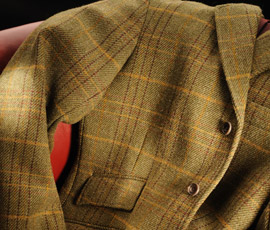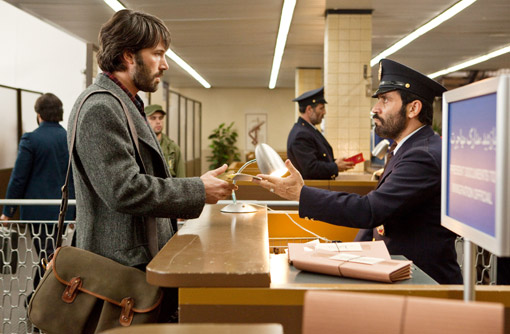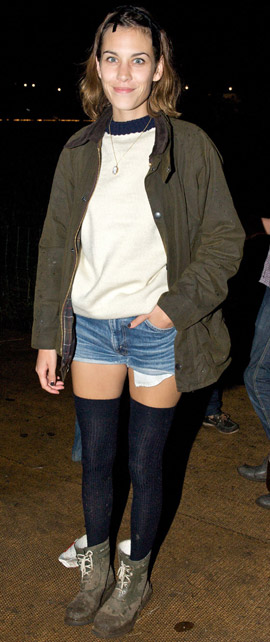How ‘farmer fashion’ became cool

First, supermodel Kate Moss made wellies cool for urbanites. Then TV presenter Alexa Chung became a “Hackney Farmer” icon with her Barbour jacket. And now Hollywood film star Ben Affleck has made sales of a British hunting bag soar.
Tweed, wax jackets, quilted jackets, flat caps, wellies, checked shirts, gilets, big-knit jumpers, hiking boots, riding boots and even jodhpurs have become must-have fashion items, sported by everyone from celebrities to high street shoppers.
“The rural/heritage trend is gradually gaining pace and is having something of a fashion moment,” says celebrity stylist and trends editor at StylistPick, Cassie Fitzpatrick.
Topman recorded a 1,267% sales increase on the previous year in its country clothing range in 2010. Then, just before Christmas 2012, Jack Wills announced a 32% sales hike, while Joules increased 9% on the previous year. Hunter boasted a 38% rise in turnover for 2011-12, and Barbour saw a £5m profit boost on figures from two years previously.
Lesser-known British brands are benefiting, too. Lake District shooting-wear company Sporting Lodge has been inundated with requests for its Brady Westmorland Special Edition “Argo” bag, which appeared in the recent Oscar-winning film Argo.

Dr Alison Goodrum, fashion theorist and leader of the Fields of Fashion research project at Nottingham Trent University, says the trend, dubbed “Rurban”, started four to five years ago.
“If I had to pin it down to a key moment, it would be when supermodel Kate Moss wore Hunter wellies to Glastonbury in 2005,” says Alison. “It was very unusual then and a bit of a turning point. A picture of her in cut-off shorts and wellies became iconic.”
Moss’s wellies-and-hotpants combo was later voted the top “festival fashion moment”, by music fans at Lovebox Festival – ahead even of Jimi Hendrix’s fringe tassel cape at Woodstock in 1969.
 Fast forward to Glastonbury two years after Moss’ moment, and music artist Lily Rose Cooper (née Allen), Peaches Geldof and fashion muse Alexa Chung were seen sporting wax jackets. The so-called Hackney Farmer was born – cool, urban young things with a taste for practical, good quality clothing.
Fast forward to Glastonbury two years after Moss’ moment, and music artist Lily Rose Cooper (née Allen), Peaches Geldof and fashion muse Alexa Chung were seen sporting wax jackets. The so-called Hackney Farmer was born – cool, urban young things with a taste for practical, good quality clothing.
“When high-profile 20-somethings start styling something like a wax jacket with hotpants, it suddenly becomes very different and is no longer seen as the preserve of what might stereotypically have been an older, male, farmer,” says Alison.
Celebrity endorsements themselves aren’t enough to start a whole fashion trend, though, she points out. “Clothing trends don’t happen on their own. An idealisation of rural lifestyle, growing popularity of allotments and grow-your-own, the slow-food movement and the good life all have their part to play.”
At a time of recession, and in an era driven by technology, urban dwellers can also perceive the countryside as honest, comforting and certain.
Products with a story
“There is something comforting and homely about donning a sheepskin gilet, a chunky knit and pair of wellies and embracing the great outdoors,” she says.
It helps, as well, when one of the world’s best-known designers, Vivienne Westwood, repeatedly says that people should stop buying throwaway clothes and instead invest in well-made, lasting items.
This appreciation of craftsmanship and heritage has come alongside the rural trend and many brands, such as Hobbs, have launched heritage lines, which help to satisfy current consumer demand for products with a story, says Alison.
 Patriotism and the desire for a slice of British heritage have also been increased by “significant events”, such as the Queen’s jubilee, the royal wedding, and the Olympics.
Patriotism and the desire for a slice of British heritage have also been increased by “significant events”, such as the Queen’s jubilee, the royal wedding, and the Olympics.
It gives the countryside more visibility, according to Alison, and there is a widespread desire among people to be a part of it and associated with it.
“Style tribes” tend to develop around different fashion trends, so when people wear certain clothes they are signalling that they belong to a particular cultural group. Wearing the “rural” look is therefore, in part, an endorsement of the countryside, the rural lifestyle and a desire to be associated with it.
“For most people, it’s not about wanting to look like a farmer, though,” points out Alison, “but about wanting to be part of that trend”. People who are more “connoisseurs” of fashion, more consciously choose it because it signals a certain lifestyle, an appreciation of craftsmanship and an allegiance to traditional values, she says. The luxury and heritage sectors are often what Alison calls ‘positional goods’ because they evoke prestige and a certain set of values.
This desire to be associated with a countryside lifestyle has happened before several times. Last time was led by fashion icons such as Princess Diana, and labels including Laura Ashley in the 1980s, and taken on by city yuppies.
In the 19th century, wealthy country squires started bringing the country and equestrian look to the city. Most famously, Beau Brummell, who Alison calls “the original dandy”, became a fashion icon by walking around town in cream jodhpurs, long-tailed coats and neckerchiefs. He is still looked to today by fashion students.
Back to the current fad, and this timeless fashion shows no sign of waning, concludes Cassie.
“Combining function and heritage has secured the rural trend’s widespread commercial appeal,” says Cassie.
“The trend provides warmth and offers protection, but is also steeped in British heritage – this combination of factors has secured its long-term legacy in fashion.”
Cassie Fitzpatrick’s fashion predictions
- The “rural/heritage” trend will continue well into early spring, making its mark especially in the menswear market.
- Despite the trend’s current grip on the high street, its popularity will dwindle in high summer but expect to see a handful of festival goers reappropriating their pair of Hunter wellies and Barbour jackets.
- The trend looks set to make a splash for autumn/winter 2013-14 collections.
- For menswear, look out for a fresh take on “rural” with a rugged seafaring style looking particular strong. This trend is all about simple rough luxe textures, homespun knits mixed with high-performance outerwear. Expect to see traditional Aran knits and polonecks being worn with herringbone tweed blazers or a weather-beaten, waxed parka jacket to complete the look.
- For womenswear, the autumn/winter 2013-14 catwalks were awash with plaids, classic Prince of Wales checks, quilting and techno-tweeds. Demure heritage is promising to be a key trend for the tailoring market and looked particularly strong at Prada, Marni, Jil Sander and Antonio Marras. The newly emerging trend combines traditional materials with a clean-cut, stripped-back design aesthetic.
| Fashion faux pas |
|---|
Here’s what you had to say on Twitter when asked which sartorial slips you had witnessed or committed. Tracksuit bottoms – no underwear and a string vest! Oh yes they shall remain nameless! Men wearing those mustard or red (I’ve even seen pink) cords aaarggghhh. Would sometimes see an elderly neighbouring farmer out doing his shopping wearing those horrible red rubber work gloves. PJs tucked into socks with mother’s crocs has to be a low for me. And what’s wrong with a belt fashioned from baler twine? I can wear moleskin for any occasion. |
See more features on our Rural Living page
